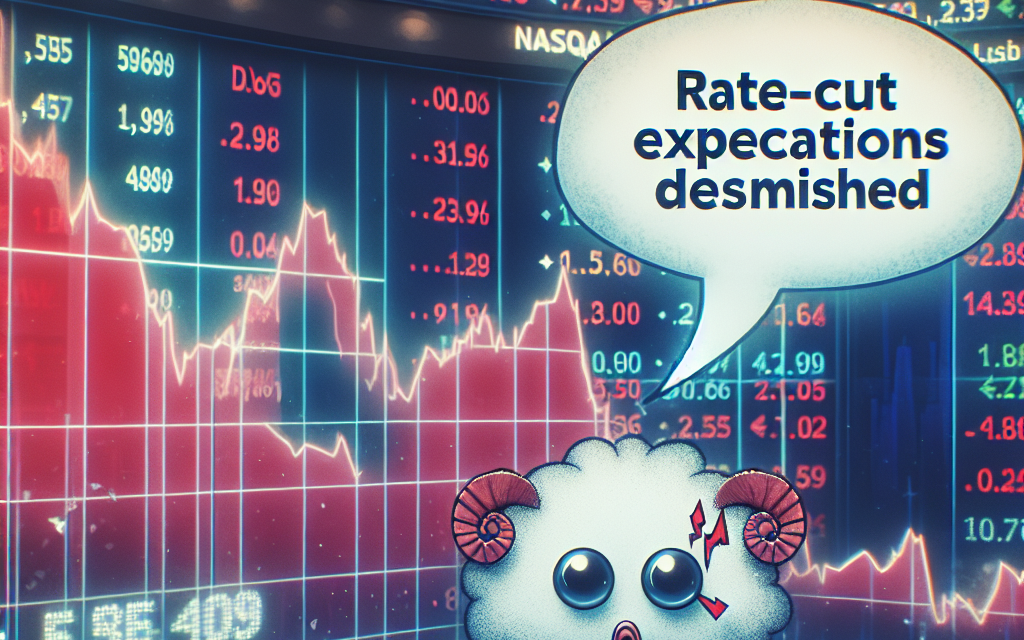“Markets Tumble as Powell Puts Rate-Cut Hopes on Hold.”
Introduction
In a recent market update, the major U.S. stock indices—Dow Jones Industrial Average, S&P 500, and Nasdaq Composite—experienced declines following remarks from Federal Reserve Chairman Jerome Powell. Powell’s comments dismissed the possibility of imminent interest rate cuts, a move that had been anticipated by some investors hoping for relief from the current monetary tightening cycle. His stance underscores the Fed’s commitment to curbing inflation, even as market participants weigh the potential impact on economic growth and corporate earnings. This development has injected a fresh wave of uncertainty into the financial markets, prompting investors to reassess their strategies amid a complex economic landscape.
Impact Of Powell’s Statements On The Stock Market
In recent developments, the stock market has experienced a notable decline, with the Dow Jones Industrial Average, the S&P 500, and the Nasdaq Composite all registering losses. This downturn can be attributed to Federal Reserve Chair Jerome Powell’s recent statements, which have effectively dismissed any immediate expectations of rate cuts. Investors, who had been hopeful for a more accommodative monetary policy, were met with a more cautious outlook, leading to a recalibration of market sentiment.
Powell’s remarks came during a closely watched press conference, where he emphasized the Federal Reserve’s commitment to its dual mandate of promoting maximum employment and maintaining price stability. While acknowledging the progress made in curbing inflation, Powell underscored the need for continued vigilance. He highlighted that inflation, although moderating, remains above the Fed’s target, necessitating a cautious approach to monetary policy. This stance has effectively quashed any near-term hopes for rate cuts, which many investors had anticipated as a potential catalyst for market growth.
The immediate impact of Powell’s statements was evident in the stock market’s reaction. The Dow Jones Industrial Average, a key barometer of the market’s health, fell sharply as investors digested the implications of a prolonged period of higher interest rates. Similarly, the S&P 500, which represents a broader swath of the market, also experienced a decline, reflecting the widespread impact of Powell’s comments. The tech-heavy Nasdaq Composite was not immune to these developments, as technology stocks, which are particularly sensitive to interest rate changes, faced significant pressure.
Transitioning to the broader implications, Powell’s dismissal of rate-cut expectations has introduced a new layer of uncertainty into the market. Investors, who had been positioning themselves for a more dovish Fed, are now grappling with the reality of a potentially extended period of elevated rates. This shift in expectations has prompted a reassessment of investment strategies, with market participants now weighing the potential impact on corporate earnings and economic growth.
Moreover, Powell’s statements have also reignited concerns about the potential for a slowdown in economic activity. Higher interest rates can lead to increased borrowing costs for businesses and consumers alike, potentially dampening spending and investment. This, in turn, could weigh on corporate profits, further influencing stock valuations. As a result, investors are now closely monitoring economic indicators for signs of resilience or weakness, as they seek to navigate this evolving landscape.
In addition to the immediate market reaction, Powell’s comments have also sparked a broader debate about the future trajectory of monetary policy. While some analysts argue that the Fed’s cautious approach is warranted given the persistent inflationary pressures, others contend that a more aggressive stance could stifle economic growth. This divergence of opinions underscores the complexity of the current economic environment and the challenges faced by policymakers in striking the right balance.
In conclusion, Jerome Powell’s recent statements have had a profound impact on the stock market, as evidenced by the declines in the Dow, S&P 500, and Nasdaq. By dismissing expectations of imminent rate cuts, Powell has introduced a new dynamic into the market, prompting investors to reassess their strategies and consider the potential implications for economic growth. As the market continues to navigate this period of uncertainty, the focus will remain on the Federal Reserve’s actions and their broader impact on the financial landscape.
Analysis Of Dow, S&P 500, And Nasdaq Performance
In recent trading sessions, the stock market has experienced a notable downturn, with the Dow Jones Industrial Average, the S&P 500, and the Nasdaq Composite all registering declines. This downward trend can be largely attributed to Federal Reserve Chair Jerome Powell’s recent comments, which have effectively dismissed any immediate expectations for rate cuts. Investors, who had been hopeful for a more dovish monetary policy stance, were met with a more cautious outlook, leading to a recalibration of market expectations.
The Dow Jones Industrial Average, a key barometer of the U.S. stock market, has seen a decline as investors digest Powell’s remarks. The index, which comprises 30 large publicly traded companies, is often viewed as a reflection of the broader economic landscape. The recent dip suggests that investors are reassessing their positions in light of the Federal Reserve’s commitment to maintaining higher interest rates for an extended period. This stance is intended to combat persistent inflationary pressures, but it also raises concerns about potential impacts on economic growth and corporate profitability.
Similarly, the S&P 500, which represents a broader spectrum of the market with its inclusion of 500 leading companies, has also experienced a decline. The index’s performance is often seen as a proxy for the overall health of the U.S. economy. The recent downturn indicates that investors are wary of the implications of sustained high interest rates on consumer spending and business investment. As borrowing costs remain elevated, companies may face increased challenges in financing expansion plans, which could, in turn, affect their earnings potential.
Meanwhile, the Nasdaq Composite, heavily weighted towards technology and growth-oriented stocks, has not been immune to the broader market’s decline. The tech sector, which has been a significant driver of market gains in recent years, is particularly sensitive to changes in interest rate expectations. Higher rates can lead to increased discount rates for future earnings, thereby reducing the present value of these companies’ projected cash flows. Consequently, tech stocks have faced heightened volatility as investors reassess their growth prospects in a higher-rate environment.
Transitioning from the immediate market reactions, it is important to consider the broader economic context in which these developments are unfolding. The Federal Reserve’s decision to maintain a hawkish stance is rooted in its mandate to ensure price stability. Inflation, which has been a persistent concern, necessitates a careful balancing act between curbing price increases and supporting economic growth. Powell’s comments underscore the central bank’s commitment to this delicate equilibrium, even if it means tempering market expectations for rate cuts.
Looking ahead, investors will likely continue to monitor economic indicators closely, seeking signs of inflationary trends and potential shifts in the Federal Reserve’s policy stance. Employment data, consumer spending patterns, and corporate earnings reports will all play crucial roles in shaping market sentiment. As the economic landscape evolves, market participants will need to navigate a complex interplay of factors that influence asset valuations and investment strategies.
In conclusion, the recent declines in the Dow, S&P 500, and Nasdaq reflect a market in flux, grappling with the implications of a steadfast Federal Reserve policy. While Powell’s dismissal of rate-cut expectations has introduced a degree of uncertainty, it also reaffirms the central bank’s commitment to its inflation-fighting mandate. As investors adjust to this new reality, the focus will remain on economic data and policy signals that could provide further clarity on the path forward.
Investor Reactions To Rate-Cut Dismissal
In the wake of Federal Reserve Chair Jerome Powell’s recent remarks, investor sentiment has taken a noticeable shift, leading to declines in major stock indices such as the Dow Jones Industrial Average, the S&P 500, and the Nasdaq Composite. Powell’s dismissal of imminent rate-cut expectations has sent ripples through the financial markets, prompting investors to reassess their strategies and positions. This development comes at a time when market participants were eagerly anticipating potential monetary easing, hoping it would provide a cushion against economic uncertainties and bolster market confidence.
Powell’s comments, delivered during a closely watched press conference, emphasized the Federal Reserve’s commitment to maintaining its current monetary policy stance. He underscored the importance of data-driven decision-making, indicating that any future rate adjustments would be contingent upon sustained economic indicators rather than speculative forecasts. This pragmatic approach, while intended to reassure markets of the Fed’s vigilance, has instead sparked concerns among investors who had been banking on a more dovish policy shift.
The immediate reaction in the stock market was palpable. The Dow Jones Industrial Average, a barometer of blue-chip stocks, experienced a notable decline as investors recalibrated their expectations. Similarly, the S&P 500, which represents a broader swath of the market, also saw a downturn, reflecting the widespread impact of Powell’s statements. The tech-heavy Nasdaq Composite was not immune to these developments, as technology stocks, often sensitive to interest rate changes, faced increased selling pressure.
Investors’ reactions to Powell’s dismissal of rate-cut expectations can be attributed to several factors. Firstly, the prospect of prolonged higher interest rates raises concerns about borrowing costs for businesses and consumers alike. Higher rates can lead to increased expenses for companies, potentially squeezing profit margins and dampening growth prospects. For consumers, elevated borrowing costs can translate into reduced spending power, which in turn can affect corporate revenues and earnings.
Moreover, the absence of anticipated rate cuts may also influence investor sentiment by altering the risk-reward calculus. In a low-interest-rate environment, equities often become more attractive as investors seek higher returns compared to fixed-income securities. However, with the possibility of sustained higher rates, the allure of equities may diminish, prompting a reevaluation of asset allocations.
Furthermore, Powell’s remarks have implications for the broader economic outlook. By signaling a cautious approach to rate adjustments, the Federal Reserve appears to be prioritizing inflation control over immediate economic stimulus. This stance, while aimed at ensuring long-term economic stability, may lead to short-term volatility as markets adjust to the new reality.
In light of these developments, investors are likely to adopt a more cautious approach, focusing on sectors and companies with strong fundamentals and resilience to interest rate fluctuations. Diversification and risk management strategies may gain prominence as market participants navigate the evolving landscape.
In conclusion, Jerome Powell’s dismissal of rate-cut expectations has triggered a significant reaction among investors, leading to declines in major stock indices. As the market digests this information, the focus will likely shift towards understanding the implications of sustained higher interest rates on corporate performance and economic growth. While uncertainty looms, investors are expected to adapt their strategies, seeking opportunities that align with the evolving monetary policy environment.
Historical Context Of Rate-Cut Expectations

In the ever-evolving landscape of financial markets, the anticipation of interest rate adjustments by the Federal Reserve has long been a focal point for investors. Historically, the expectation of rate cuts has often been associated with efforts to stimulate economic growth during periods of economic slowdown. This anticipation can lead to significant fluctuations in stock market indices, as investors adjust their portfolios in response to potential changes in monetary policy. The recent decline in the Dow Jones Industrial Average, S&P 500, and Nasdaq Composite underscores the sensitivity of the markets to Federal Reserve Chair Jerome Powell’s remarks, which dismissed the likelihood of imminent rate cuts.
To understand the current market dynamics, it is essential to consider the historical context of rate-cut expectations. Traditionally, the Federal Reserve has employed interest rate cuts as a tool to lower borrowing costs, thereby encouraging consumer spending and business investment. This approach has been particularly evident during economic downturns, such as the financial crisis of 2008 and the COVID-19 pandemic in 2020, when the Fed slashed rates to near-zero levels to support the economy. Consequently, investors have often viewed the prospect of rate cuts as a positive signal, anticipating that such measures would bolster economic activity and, by extension, corporate earnings.
However, the relationship between rate-cut expectations and stock market performance is not always straightforward. While lower interest rates can enhance the attractiveness of equities by reducing the discount rate applied to future earnings, they can also signal underlying economic weaknesses that may weigh on market sentiment. In this context, Powell’s recent comments have introduced a layer of complexity to the current market environment. By dismissing the likelihood of rate cuts, Powell has effectively communicated the Fed’s confidence in the resilience of the U.S. economy, despite ongoing challenges such as inflationary pressures and geopolitical uncertainties.
This stance has prompted a reassessment among investors, who must now navigate a landscape where the prospect of rate cuts is not on the immediate horizon. The resulting decline in major stock indices reflects a recalibration of expectations, as market participants adjust to the reality of a more hawkish monetary policy stance. Moreover, Powell’s remarks have highlighted the delicate balance the Federal Reserve must strike between supporting economic growth and containing inflation, a challenge that has become increasingly pronounced in recent months.
As investors digest Powell’s comments, it is important to recognize that the stock market’s reaction is part of a broader narrative that encompasses both domestic and global economic factors. While the absence of rate cuts may temper short-term market enthusiasm, it also underscores the Fed’s commitment to maintaining price stability, a key pillar of long-term economic health. In this regard, the current market volatility can be seen as a reflection of the complex interplay between monetary policy expectations and broader economic conditions.
In conclusion, the decline in the Dow, S&P 500, and Nasdaq following Powell’s dismissal of rate-cut expectations serves as a reminder of the intricate relationship between monetary policy and market dynamics. By understanding the historical context of rate-cut expectations, investors can better appreciate the nuances of the current market environment and make informed decisions as they navigate the challenges and opportunities that lie ahead. As always, the path forward will be shaped by a multitude of factors, requiring vigilance and adaptability from all market participants.
Future Projections For Major Stock Indices
In recent developments, the stock market has experienced a notable downturn, with the Dow Jones Industrial Average, the S&P 500, and the Nasdaq Composite all registering declines. This shift in market sentiment can be largely attributed to Federal Reserve Chair Jerome Powell’s recent remarks, which effectively dismissed any immediate expectations for rate cuts. As investors digest these comments, it becomes crucial to explore the future projections for these major stock indices, considering the broader economic landscape and potential influencing factors.
To begin with, the Dow Jones Industrial Average, a key barometer of the U.S. stock market, has faced downward pressure as investors recalibrate their expectations in light of Powell’s statements. Historically, the Dow has been sensitive to interest rate changes, given its composition of large-cap companies that are often impacted by borrowing costs. Looking ahead, analysts suggest that the Dow may continue to experience volatility as market participants weigh the implications of sustained higher interest rates. However, it is also important to consider the resilience of the companies within the index, many of which have demonstrated the ability to adapt to changing economic conditions.
Similarly, the S&P 500, which represents a broader spectrum of the U.S. economy, has not been immune to the recent market downturn. The index’s decline reflects a broader reassessment of growth prospects, particularly in sectors that are more sensitive to interest rate fluctuations, such as technology and consumer discretionary. Despite this, some analysts remain cautiously optimistic about the S&P 500’s long-term trajectory. They point to the index’s historical ability to recover from downturns and the potential for sectors like healthcare and energy to provide a stabilizing influence. Moreover, the ongoing economic recovery and corporate earnings growth could serve as catalysts for future gains, provided that inflationary pressures remain under control.
Turning to the Nasdaq Composite, which is heavily weighted towards technology stocks, the impact of Powell’s comments has been particularly pronounced. The tech sector, known for its reliance on low borrowing costs to fuel innovation and expansion, has faced increased scrutiny as investors reassess valuations in a higher interest rate environment. Nevertheless, the long-term outlook for the Nasdaq remains promising, driven by the continued demand for technological advancements and digital transformation across industries. While short-term volatility is expected, the index’s potential for growth remains intact, supported by the ongoing evolution of sectors such as artificial intelligence, cloud computing, and renewable energy.
In conclusion, while the immediate reaction to Jerome Powell’s dismissal of rate-cut expectations has been a decline in major stock indices, the future projections for the Dow, S&P 500, and Nasdaq are nuanced and multifaceted. Investors must navigate a complex landscape characterized by interest rate dynamics, sector-specific challenges, and broader economic trends. As such, a balanced approach that considers both short-term market fluctuations and long-term growth potential is essential. By staying informed and adaptable, investors can better position themselves to capitalize on opportunities that may arise as the market continues to evolve. Ultimately, while uncertainty remains a constant in the financial markets, the resilience and adaptability of these major indices offer a measure of confidence for the future.
Sector-Specific Impacts Of Market Decline
The recent decline in the stock market, marked by the Dow Jones Industrial Average, S&P 500, and Nasdaq Composite all experiencing downturns, has sent ripples across various sectors, each reacting uniquely to the broader economic signals. This market movement was largely influenced by Federal Reserve Chair Jerome Powell’s remarks, which dismissed the possibility of imminent rate cuts. As investors recalibrate their expectations, the sector-specific impacts of this market decline are becoming increasingly evident.
To begin with, the technology sector, which has been a significant driver of market gains in recent years, has shown notable sensitivity to interest rate expectations. Higher interest rates tend to increase the cost of capital, which can be particularly challenging for tech companies that rely heavily on borrowing to fuel innovation and growth. Consequently, Powell’s comments have led to a reassessment of valuations within this sector, causing a pullback in tech stocks. Companies with high price-to-earnings ratios, which are often justified by future growth prospects, are especially vulnerable in this environment. As a result, investors are exercising caution, leading to a decline in tech-heavy indices like the Nasdaq.
Meanwhile, the financial sector is experiencing its own set of challenges. Banks and financial institutions generally benefit from higher interest rates, as they can charge more for loans relative to what they pay on deposits. However, the current market sentiment is overshadowed by concerns about economic growth and the potential for a recession. These fears can dampen loan demand and increase the risk of defaults, which in turn affects banks’ profitability. Therefore, despite the theoretical benefits of a higher rate environment, financial stocks have not been immune to the broader market decline.
In contrast, the energy sector has shown some resilience amid the market downturn. Energy companies often benefit from inflationary pressures, as rising commodity prices can lead to increased revenues. However, this sector is not without its challenges. Geopolitical tensions and fluctuating oil prices add layers of complexity to the market dynamics. While some energy stocks have managed to hold their ground, the overall uncertainty in the global economic landscape continues to weigh on investor sentiment.
The consumer goods sector is also navigating a complex environment. Companies in this sector are grappling with the dual pressures of rising input costs and changing consumer behavior. Inflation has led to increased costs for raw materials and transportation, squeezing profit margins. At the same time, consumers are becoming more price-sensitive, which can limit companies’ ability to pass on these costs. As a result, consumer goods stocks have faced headwinds, contributing to the sector’s overall decline.
Lastly, the healthcare sector, often considered a defensive play during market volatility, has not been entirely insulated from the downturn. While demand for healthcare services remains relatively stable, the sector faces its own set of challenges, including regulatory uncertainties and pricing pressures. These factors have contributed to a mixed performance within the sector, with some companies faring better than others.
In conclusion, the recent decline in the stock market, driven by Powell’s dismissal of rate-cut expectations, has had varied impacts across different sectors. While some sectors have shown resilience, others are grappling with significant challenges. As investors continue to navigate this complex landscape, sector-specific dynamics will play a crucial role in shaping market outcomes.
Strategies For Investors Amid Market Volatility
In the ever-evolving landscape of financial markets, investors are constantly seeking strategies to navigate periods of volatility. Recent developments have underscored the importance of adaptability, as the Dow Jones Industrial Average, S&P 500, and Nasdaq Composite all experienced declines following Federal Reserve Chair Jerome Powell’s remarks dismissing expectations for imminent rate cuts. This shift in market sentiment has prompted investors to reassess their strategies, emphasizing the need for a balanced approach that considers both short-term fluctuations and long-term objectives.
To begin with, understanding the underlying factors contributing to market volatility is crucial. Powell’s comments, which highlighted the Federal Reserve’s commitment to maintaining higher interest rates to combat inflation, have led to increased uncertainty among investors. This has resulted in a recalibration of market expectations, as many had anticipated a more dovish stance from the central bank. Consequently, investors are now faced with the challenge of adjusting their portfolios to align with a potentially prolonged period of elevated rates.
In light of these developments, diversification remains a cornerstone strategy for mitigating risk. By spreading investments across various asset classes, sectors, and geographic regions, investors can reduce their exposure to any single market downturn. This approach not only helps cushion the impact of volatility but also positions investors to capitalize on opportunities that may arise in different areas of the market. For instance, while technology stocks have been particularly sensitive to interest rate changes, sectors such as healthcare and consumer staples may offer more stability in uncertain times.
Moreover, maintaining a long-term perspective is essential for weathering market turbulence. While short-term fluctuations can be unsettling, history has shown that markets tend to recover over time. Investors who remain focused on their long-term goals are better equipped to withstand temporary setbacks and avoid making impulsive decisions driven by fear or panic. This disciplined approach involves regularly reviewing and rebalancing portfolios to ensure alignment with one’s risk tolerance and investment objectives.
In addition to diversification and a long-term outlook, investors should also consider the role of fixed-income securities in their portfolios. With interest rates expected to remain elevated, bonds and other fixed-income instruments can provide a source of steady income and act as a counterbalance to the volatility of equities. By carefully selecting bonds with varying maturities and credit qualities, investors can create a fixed-income portfolio that complements their overall investment strategy.
Furthermore, staying informed about macroeconomic trends and central bank policies is vital for making informed investment decisions. By keeping abreast of developments such as inflation data, employment figures, and geopolitical events, investors can better anticipate potential market movements and adjust their strategies accordingly. Engaging with financial advisors and leveraging research from reputable sources can also provide valuable insights and guidance during periods of uncertainty.
In conclusion, the recent declines in the Dow, S&P 500, and Nasdaq serve as a reminder of the inherent volatility in financial markets. However, by employing strategies such as diversification, maintaining a long-term perspective, incorporating fixed-income securities, and staying informed about economic trends, investors can navigate these challenges with greater confidence. As the market continues to evolve, adaptability and resilience will remain key attributes for investors seeking to achieve their financial goals amid an ever-changing landscape.
Q&A
1. **Question:** What recent statement did Jerome Powell make regarding interest rates?
**Answer:** Jerome Powell dismissed expectations for rate cuts in the near future.
2. **Question:** How did the stock market react to Powell’s statement?
**Answer:** The stock market declined, with the Dow, S&P 500, and Nasdaq all experiencing losses.
3. **Question:** Which major stock indices were affected by Powell’s comments?
**Answer:** The Dow Jones Industrial Average, S&P 500, and Nasdaq Composite were all affected.
4. **Question:** What is the general sentiment in the market following Powell’s remarks?
**Answer:** The sentiment is negative, as investors are concerned about the continuation of higher interest rates.
5. **Question:** Why are investors concerned about the lack of rate cuts?
**Answer:** Investors are worried that sustained higher interest rates could slow economic growth and impact corporate profits.
6. **Question:** How do interest rates typically affect stock market performance?
**Answer:** Higher interest rates can lead to increased borrowing costs for companies and consumers, potentially reducing spending and investment, which can negatively impact stock market performance.
7. **Question:** What sectors might be most impacted by the continued high interest rates?
**Answer:** Interest-sensitive sectors such as real estate, utilities, and consumer discretionary might be most impacted by continued high interest rates.
Conclusion
The recent decline in the Dow, S&P 500, and Nasdaq indices reflects investor concerns following Federal Reserve Chair Jerome Powell’s dismissal of near-term rate-cut expectations. Powell’s comments suggest a continued focus on controlling inflation, which may lead to prolonged higher interest rates. This stance has dampened market sentiment, as investors had hoped for more accommodative monetary policy to support economic growth. The market’s reaction underscores the sensitivity of equity prices to monetary policy signals and highlights the ongoing uncertainty in the economic outlook.





